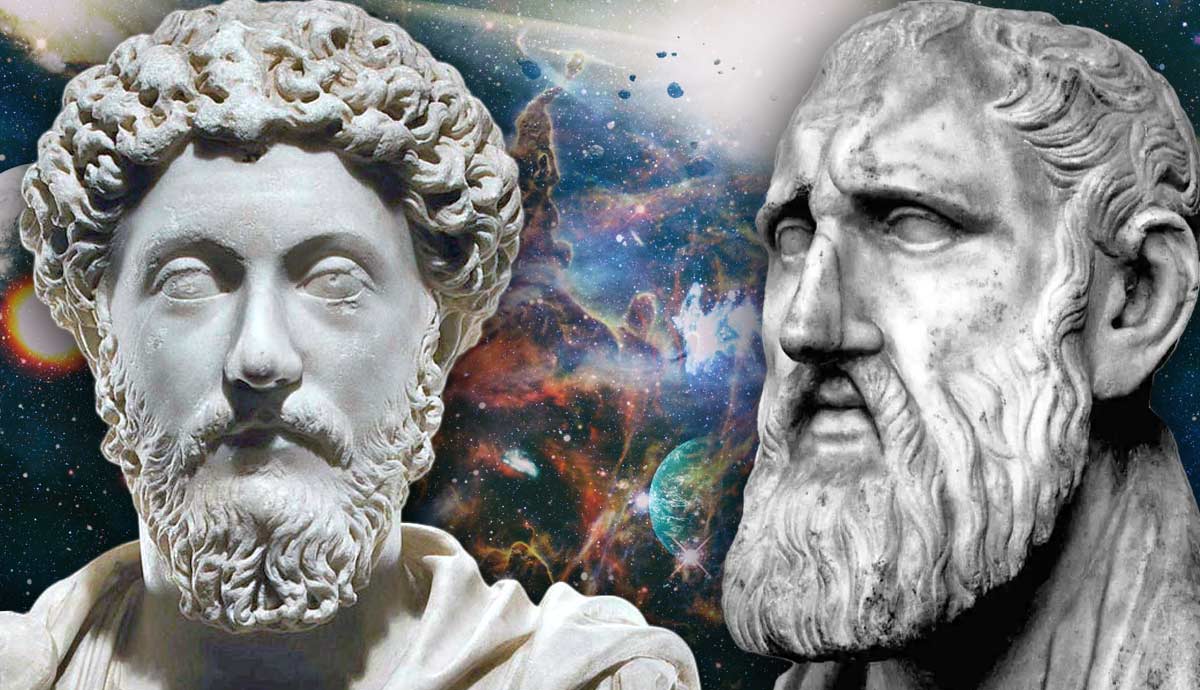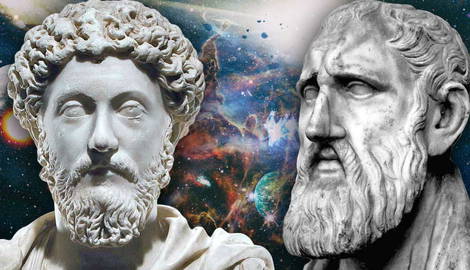
One of the most fundamental questions examined by most philosophical schools of thought is the nature of existence. According to Stoicism, everything in the universe is matter, created, animated, destroyed, and recreated by divine fire, logos. Consequently, everything is connected as a single living entity, and all things are predetermined within a providential cosmic system. This metaphysical philosophy can be explained in four key tenets.
1. How Was the Cosmos Created According to the Stoics?

First, let’s explore the big metaphysical picture about how the world came to be according to Stoicism. For the Stoics, the cosmos is made from four elements: fire, water, air, and earth. Everything is a compound mixture of these elements and is constantly in motion.
Like Plato in the Timaeus, the Stoics believed the cosmos is alive in some sense. But while Plato postulated a separate creator that gave the world a soul, the Stoics show a preference for a radically unified conception of the cosmos. There is a divinity that makes the cosmos alive, but rather than sit separate and above, that divinity is material and immanent throughout the cosmos, identified with the purest form of the element fire.
According to them, fire has varying properties, both creative (or “technical”, that is, craftsman-like) and destructive. Creative fire is the element responsible for life and motion.

This is how, according to the Stoic theory, the universe came to be, and how anything was created. The starting point of the world, where all that exists is the fiery perfection of god, Zeus, and that is pure fire.
For some reason known only to god’s perfect rationality, creation begins when part of the divine fire condenses into a liquid containing the seed of all future objects and changes. The liquid then undergoes two further transformations. Some of it vaporizes into air, and some condenses further into earth. Pure elemental fire also remains. Thus, the evolving cosmos now has all its basic material components.
However, the world is only partially stable. The power of the fire increases over time in an orderly pattern, until one day, in the distant future, its “fuel” (derived from the other elements) will be exhausted, and the entire cosmos will become flame, returning once again to its singular starting point. Then the whole process will repeat again, continuously forever.
2. Logos and Fire in Stoicism

Now, let’s get a bit deeper into the significance of the most fundamental principles in their metaphysics: fire and logos. For the Stoics, the immanent rational principle guiding the world’s changes was a form of fire that has a kind of life-giving breath, called pneuma. Pneuma was a traditional word for breath, but for the Stoics, it became a technical term that meant the animating force in the world.
The universe, they believed, is governed by a rational and divine principle that they referred to as “Logos.” They saw this Logos as a fiery, active force that pervades all things and brings order and harmony to the cosmos, and fire represents the dynamic and creative nature of the Logos.

Furthermore, the Stoics differentiated between two kinds of fire: the active fire and the passive fire. The active fire, also known as the creative fire or the generative fire, represents the active principle that brings about transformation and growth in the universe. It symbolizes the dynamic and creative nature of the divine Logos. This active fire is seen as the source of life and vitality, driving the processes of growth, change, and development in the world.
The passive fire represents the recipient or receptor of the active fire. It refers to matter or the material world that undergoes transformation through the influence of active fire. Passive fire is seen as the receptive element that is acted upon and shaped by the active fire’s creative power.
They believed that these two fires, the active and passive, are inseparable and interconnected. They saw the active fire as permeating and animating the passive fire, giving it life and form. Together, these two fires represent the dynamic interplay between the creative force and the material world.

Aristotle, whose cosmology is in some ways very similar to that of the Stoics, had held that the cosmos was eternal, sustained by a non-physical god “outside” it, a god that serves as the ultimate and unchanging mover of the cosmos.
The Stoic cosmos is radically unified, and its sustaining god is not external. For them, god is the productive, active, or creative feature of the world, penetrating everywhere. The creative feature that they are mostly referring to is fire, and they give it a god-like character. That’s why they often mention it under the name of Zeus.
3. Stoic Cosmology About Different Beings and Entities

Now let’s look at the Stoic cosmology. According to Stoic cosmology, there are various classes of various kinds of entities in the world. They distinguish four levels of such entities by the kinds of capacities which they exhibit.
The simplest beings are inert, for example minerals, and their essential capacity is merely the possession of basic attributes and the ability to hold themselves together as unified objects. This “holding together” and possession of basic attributes are described as their hexis, a term derived from the Greek verb “to have.”
More elaborate are things that can grow, nourish themselves, and reproduce. Plants are the best example, and they are held together and kept alive by their physis or “nature.” Plants are not self-moving and don’t perceive, although they do react to their environments in limited ways.

The next level is the animals, which are perceptual self-movers. The principle that makes them what they are is not just nature, but a “soul” or psyche. Things with souls have more powers than just nourishment and reproduction. They can also perceive, desire, and move.
Humans are located on the level above the animals because their souls are even more sophisticated in virtue. They have rationality. And it is because of reason, logos, that they have a rational soul. Humans do everything that lower entities do, but rationally. This means that we have the capacity to respond critically to our perceptions and to process and manipulate them as well. At the top of the scale is the perfect logos or the god(s). They are not even classified into the four layers of entities, because they are beyond the scale to begin with.
4. The Stoic Doctrine of Causation and Determinism

Stoicism’s doctrine of causation and determination is probably its most controversial. First, they recognized that only matter can act or be acted upon, and so all causes are relationships between bodies. Secondly, they stated that there can be no uncaused events or entities. That is because the rational power of divine pneuma is what causes things to be what they are and do what they do. Consequently, they come up with their third postulate, that everything in the world is predetermined.
Stoic determinism is so demanding and strict that it progresses into fatalism. Fatalism suggests that everything is predetermined and that there is no place for change at all. This leaves us with no way to do something that can contribute to changing the world because there is nothing that we can do that isn’t already predetermined.

Everything that happens in the world is part of a coordinated network of causes, effects, events, and objects, and this network is the expression of a master plan aimed at the best possible outcome.
There are many philosophical objections to this form of determinism, but two stand out. First, if everything is caused, what about human actions? Are my actions, decisions, and even my thoughts determined in advance by the “will of Zeus?” Does that mean that in some sense I am not free to make real choices, that I am a sort of puppet?
The other one concerns all the bad things that go on in the world. If all the events happening in the world are aimed at producing good, how is there so much badness in the world? If there is a divine plan causing everything in the world, why isn’t everything perfect, or at least a great deal better than it seems to be?
Many Stoics tried to answer these issues, especially the Roman emperor Marcus Aurelius.








